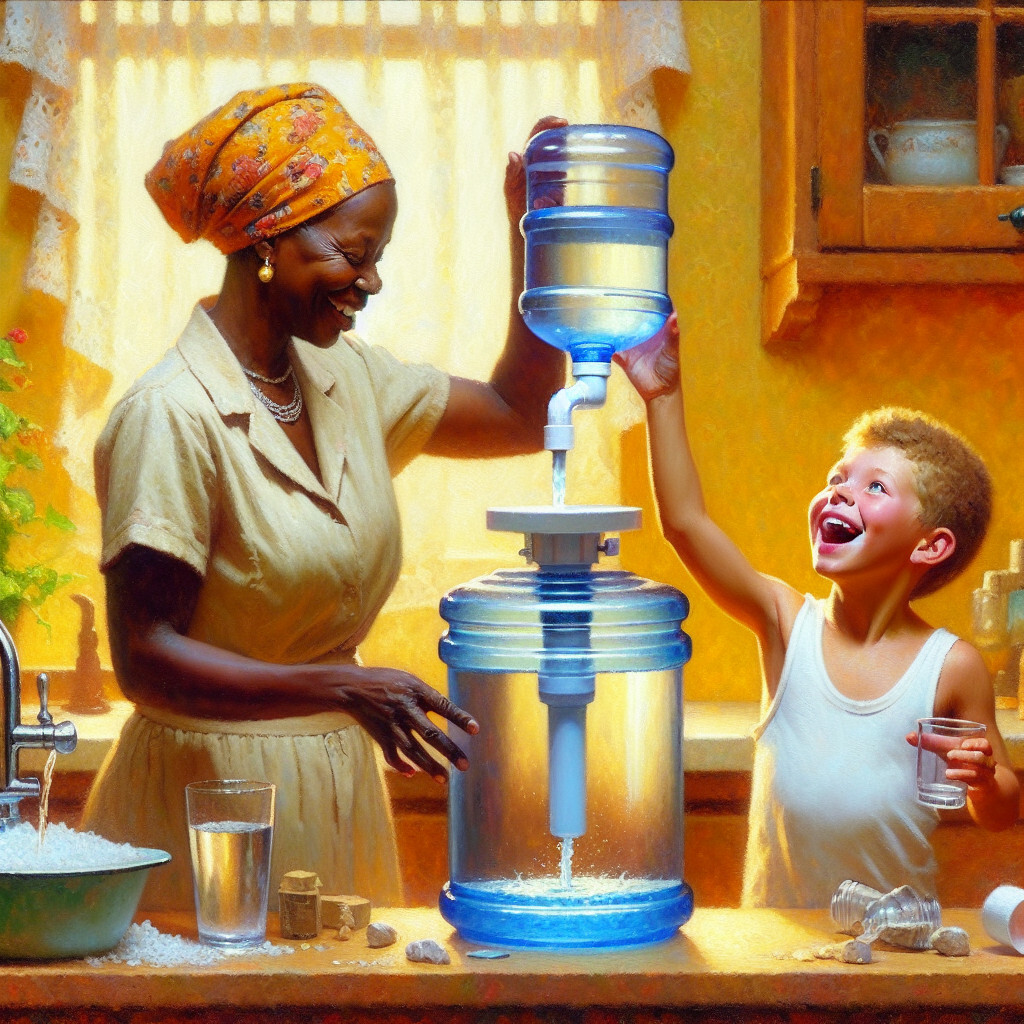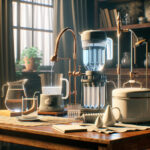-
Table of Contents
“Home-made Purity: Crafting Filtered Water in Your Own Kitchen!”
Introduction

Yes, it is possible to make filtered water at home. This process involves removing impurities from water through a fine physical barrier, a chemical process, or a biological process. There are several methods to filter water at home, including using activated carbon, reverse osmosis, distillation, or ultraviolet technology. These methods can help in reducing contaminants such as bacteria, viruses, algae, fungi, parasites, metals like lead, and chemical pollutants from the water, making it safe for consumption.
DIY Methods for Making Filtered Water at Home
The quest for clean, safe drinking water is a universal concern. With the increasing awareness about the potential contaminants in tap water and the high cost of bottled water, many people are exploring the possibility of making filtered water at home. This article will delve into the various do-it-yourself (DIY) methods for making filtered water at home, providing a comprehensive guide for those who wish to take control of their water quality.
The first method to consider is the use of a water pitcher filter. These are simple, affordable devices that can be purchased at most home goods stores. The pitcher contains a replaceable filter that removes contaminants as water passes through it. While this method is easy and convenient, it is important to note that not all pitcher filters are created equal. Some are more effective at removing certain contaminants than others, so it is crucial to research and choose a model that suits your specific needs.
Another DIY method for making filtered water at home is through the use of a faucet-mounted filter. These devices attach directly to your kitchen faucet and filter water as it flows from the tap. Faucet-mounted filters are typically more effective than pitcher filters at removing contaminants, but they can also be more expensive and may require professional installation.
For those who are willing to invest a bit more time and money, a reverse osmosis system can provide an even higher level of filtration. These systems use a semi-permeable membrane to remove a wide range of contaminants, including heavy metals, bacteria, and viruses. While reverse osmosis systems are highly effective, they can be costly and require professional installation. Additionally, they produce a significant amount of waste water, which may be a concern for those who are environmentally conscious.
A more traditional method of water filtration is distillation. This process involves boiling water to create steam, then cooling the steam to collect purified water. Distillation can remove a wide range of contaminants, including heavy metals, bacteria, and viruses. However, it is a slow process and requires a significant amount of energy, making it less practical for daily use.
Lastly, for those who prefer a more natural approach, there is the option of using a ceramic water filter. These filters are made from porous ceramic material that can trap contaminants while allowing water to pass through. Ceramic filters are affordable and easy to use, but they may not remove all types of contaminants.
In conclusion, there are several DIY methods for making filtered water at home, each with its own advantages and disadvantages. The best method for you will depend on your specific needs, budget, and level of commitment. Regardless of the method you choose, it is important to regularly replace or clean your filter to ensure its effectiveness. By taking control of your water quality, you can enjoy the peace of mind that comes with knowing your water is clean and safe to drink.
Understanding the Process of Home Water Filtration
Water is an essential element of life, and its quality directly impacts our health and wellbeing. With increasing concerns about the purity of tap water, many people are turning to home water filtration systems. The question that arises is, can one make filtered water at home? The answer is a resounding yes. Understanding the process of home water filtration can help you ensure that the water you and your family consume is clean and safe.
The process of home water filtration involves removing impurities from water using a barrier, a chemical process, or a biological process. The primary aim is to eliminate contaminants such as bacteria, viruses, algae, fungi, minerals, and man-made pollutants that may be present in the water. The result is water that not only tastes better but is also healthier to consume.
The first step in the filtration process is pre-filtration, which is designed to remove large particles from the water. This is typically achieved using a physical barrier such as a screen or a filter. The pre-filtration stage is crucial as it prevents the subsequent stages of filtration from being clogged by large particles, thereby ensuring the efficiency and longevity of the entire filtration system.
Following pre-filtration, the water undergoes a process known as activated carbon filtration. Activated carbon is a form of carbon that has been processed to have small, low-volume pores. These pores increase the surface area available for adsorption, a chemical reaction where certain particles are attracted to activated carbon and bond with it. This process is particularly effective at removing organic compounds and chlorine, which can affect the taste and odor of the water.
The next stage in the filtration process is reverse osmosis. This involves forcing the water under pressure through a semi-permeable membrane, which allows water molecules to pass through but blocks most dissolved salts, bacteria, and other impurities. Reverse osmosis is one of the most effective methods of water filtration, capable of removing up to 99% of all contaminants.
The final stage of the filtration process is known as post-filtration or polishing. This stage is designed to remove any remaining impurities that may have slipped through the previous stages. It typically involves another pass through an activated carbon filter, ensuring that the water is as clean and pure as possible before it is consumed.
In conclusion, making filtered water at home is not only possible but also a practical and effective way to ensure the quality of your drinking water. By understanding the process of home water filtration, you can make informed decisions about the best filtration system for your needs. Whether you’re concerned about the taste of your tap water, the potential health risks of contaminants, or simply want to reduce your environmental impact by using less bottled water, a home water filtration system can provide a solution. With a variety of systems available, from simple pitcher filters to more complex under-sink installations, there’s a home water filtration option to suit every household.
Steps to Create Your Own Water Filter at Home
Water is an essential element of life, and its quality directly impacts our health and wellbeing. With increasing concerns about water pollution and the safety of tap water, many people are turning to water filters to ensure they have access to clean, safe drinking water. But did you know that you can make filtered water at home? Yes, it’s possible, and it’s simpler than you might think.
The first step in creating your own water filter at home is gathering the necessary materials. You will need a plastic bottle or a clean glass jar, gravel, sand, activated charcoal, a piece of cloth or coffee filter, and a rubber band. These materials are readily available in most homes or can be easily purchased from a local store.
Once you have all the materials, start by cutting the bottom off the plastic bottle. If you’re using a glass jar, you can skip this step. Next, turn the bottle upside down and secure the cloth or coffee filter over the bottle’s mouth using a rubber band. This cloth or coffee filter will act as the first layer of filtration, catching larger particles and debris.
The next step involves creating layers within the bottle. Start by adding a layer of activated charcoal. Activated charcoal is excellent at removing toxins and heavy metals from water. It’s commonly used in water filtration systems and can be easily purchased online or from a local health store.
After the activated charcoal, add a layer of sand. Sand acts as a natural filter, trapping smaller particles that the cloth or coffee filter might have missed. Following the sand, add a layer of gravel. The gravel layer helps to support the sand and activated charcoal layers and prevents them from getting washed away when you add water.
Now that your homemade water filter is ready, it’s time to test it. Slowly pour tap water or any unfiltered water into the top of the bottle and let it trickle down through the layers of gravel, sand, and activated charcoal. As the water passes through these layers, impurities are trapped, and cleaner water collects at the bottom.
It’s important to note that while this homemade water filter can significantly improve the quality of your water by removing visible impurities and some invisible ones, it may not remove all potential contaminants. For instance, it may not effectively remove certain bacteria, viruses, or chemical pollutants. Therefore, it’s always advisable to boil the water after filtration, especially if you’re unsure of the water’s initial quality.
In conclusion, making filtered water at home is not only possible but also quite straightforward. With a few readily available materials, you can create your own water filter and improve the quality of your drinking water. However, remember that this should not replace a comprehensive water filtration system, especially if your tap water is known to contain harmful contaminants. It’s always best to have your water tested to understand what contaminants you’re dealing with and then choose a filtration system that effectively removes those specific contaminants.
The Benefits and Challenges of Making Filtered Water at Home
The quest for clean, safe drinking water is a universal concern. With the increasing awareness of the potential contaminants that may be present in tap water, many individuals are exploring the possibility of making filtered water at home. This process, while beneficial, also presents its own set of challenges.
The benefits of making filtered water at home are numerous. Firstly, it provides an assurance of safety. Tap water, although generally safe to drink, can sometimes contain harmful substances such as lead, chlorine, and other chemicals. These substances can pose health risks when consumed over a long period. By filtering water at home, one can significantly reduce the exposure to these potential contaminants, thereby safeguarding health.
Secondly, homemade filtered water can be more cost-effective in the long run. While the initial investment in a water filtration system may seem substantial, it can save money over time. Bottled water, often seen as a safer alternative to tap water, can be expensive. By filtering water at home, one can enjoy clean, safe water at a fraction of the cost.
Thirdly, making filtered water at home is environmentally friendly. The production and disposal of plastic water bottles contribute significantly to environmental pollution. By opting for home-filtered water, one can reduce their carbon footprint and contribute to environmental conservation.
Despite these benefits, making filtered water at home is not without its challenges. One of the main challenges is the initial cost. High-quality water filtration systems can be expensive. However, it’s important to view this as an investment in health and long-term savings.
Another challenge is maintenance. Water filters need to be replaced regularly to ensure they continue to effectively remove contaminants. This requires a commitment to ongoing maintenance and the associated costs.
Additionally, not all water filters are created equal. Some may only remove certain types of contaminants. Therefore, it’s crucial to understand the specific contaminants present in your tap water and choose a filtration system that effectively removes them. This may require professional testing and consultation, adding to the overall cost and complexity of the process.
Lastly, while home water filtration can significantly reduce the presence of many contaminants, it may not eliminate all potential hazards. Some contaminants, such as certain bacteria and viruses, may require more advanced treatment methods. Therefore, it’s important to remember that while home water filtration can greatly improve the quality and safety of drinking water, it should not be relied upon as the sole means of water purification.
In conclusion, making filtered water at home offers numerous benefits, including improved health safety, cost savings, and environmental conservation. However, it also presents challenges such as initial costs, ongoing maintenance, and the need for careful selection and use of filtration systems. By understanding these benefits and challenges, individuals can make informed decisions about whether home water filtration is the right choice for them.
Q&A
1. Question: Can I make filtered water at home?
Answer: Yes, you can make filtered water at home using a water filtration system or a water purifier.
2. Question: What equipment do I need to filter water at home?
Answer: You would need a water filtration system, which could be a pitcher filter, faucet attachment, under-sink system, or a whole-house filtration system.
3. Question: Is homemade filtered water as safe as bottled water?
Answer: Yes, homemade filtered water can be as safe as bottled water if the filtration system used is effective in removing harmful contaminants.
4. Question: How often should I change the filter in my home water filtration system?
Answer: The frequency of changing the filter depends on the type of filtration system used. Generally, it is recommended to change the filter every 2-6 months or as per the manufacturer’s instructions.
Conclusion
Yes, you can make filtered water at home using various methods such as boiling, using a water filter pitcher, installing a faucet-mounted filter, or using a distillation process. These methods can help remove impurities and make the water safer for consumption.






